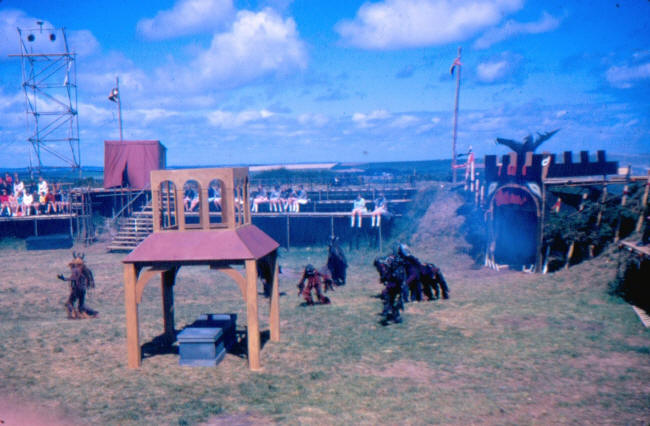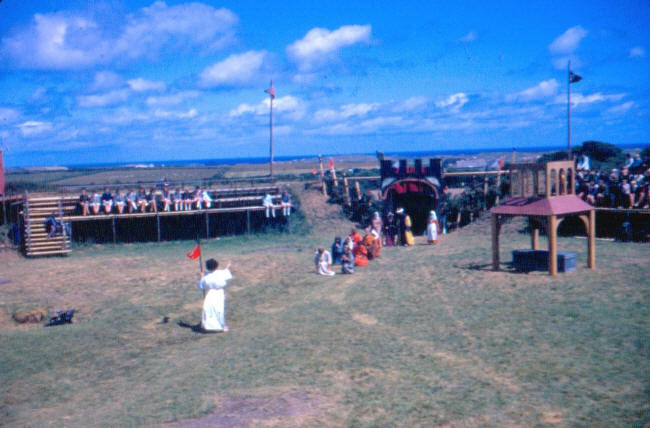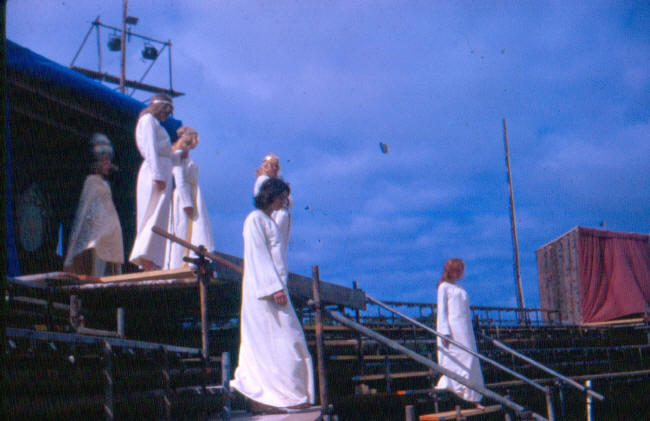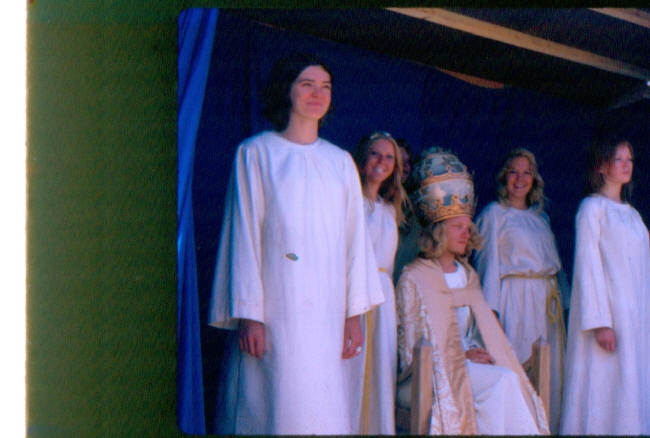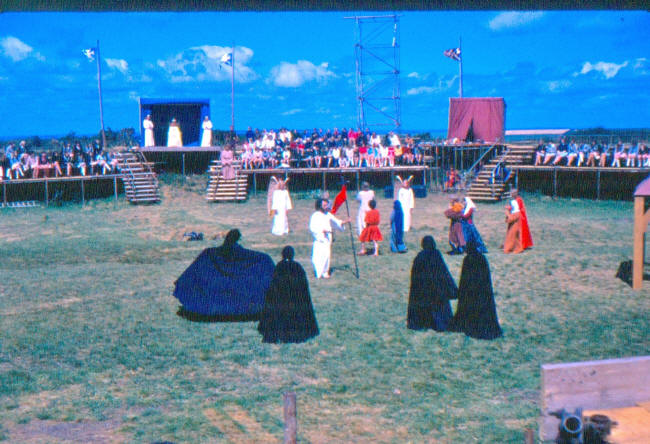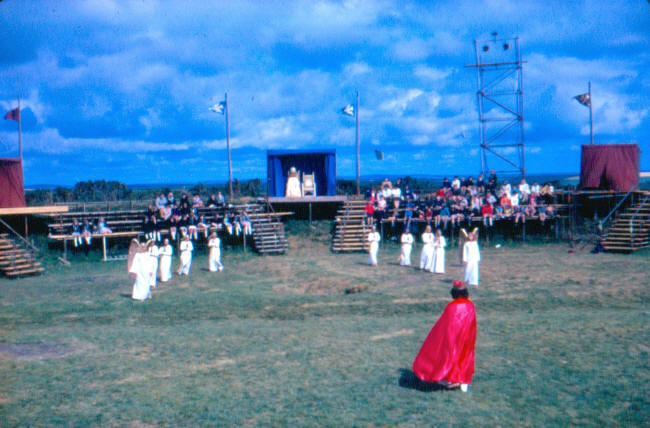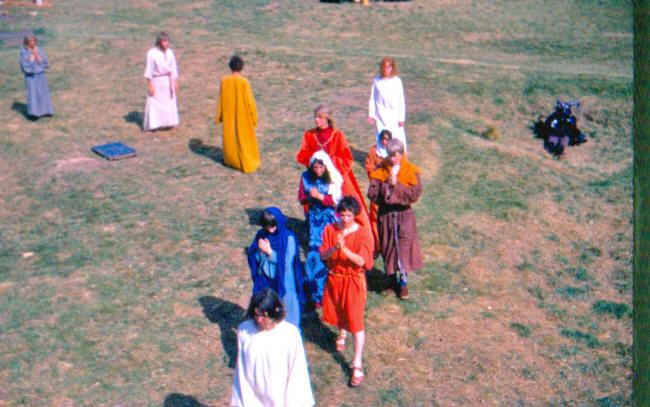|
|
| home | features | exhibitions | interviews | profiles | webprojects | gazetteer | links | archive | forum |
|
The Ordinalia 1969 In 1969 the Drama Department at Bristol University staged the Cornish medieval mystery plays for the first time in over 300 years. One of the directors, Sidney Higgins, took photos during the dress rehearsal at St Piran's Round, and recently made them available to artcornwall.org. The images include representations of God and The Devil, Heaven and Hell.
The
manuscript collection known as the Cornish Ordinalia takes its name
from the title of the first of the three religious plays it contains
and the language in which all three are written. The plays are
Ordinale de origo mundi (The
Ordinal of the Beginning of the World, 2,846 lines),
Passio Domini nostri Jhesu Christi
(The Passion of Our Lord Jesus
Christ, 3,242 lines), and
Ordinale de resurrexione Jhesu Christi (The
Ordinal of the Resurrection of Our Lord Jesus Christ, 2,646
lines).
The dramatist or dramatists wrote the play primarily in Middle Cornish, with Latin stage directions. Although it is one of the earlier extended examples of Cornish to survive, the Ordinalia illustrates the language in decline, with English words, phrases, and whole lines incorporated into the Cornish verses with little sense of dissonance. (The last native speakers of Cornish, a Celtic language, died before 1900, although a movement later formed to revive the language.) In general, the plays are composed in seven-syllable lines, usually in stanzas of either six or eight lines. Although there is no incontrovertible evidence that the manuscript was ever a performance text, it includes three schematic diagrams immediately after the character list for each day's play. These indicate a pleyn-en-gwary (or “playing place”) mode of presentation and parallel the diagrams found in the Cornish Beunans Meriasek (Peniarth MS 105) and—to a lesser extent—the stage plan of The Castle of Perseverance found in the East Anglian Macro play manuscript. Latin stage directions describe a domus, tenti, sedes, and pulpiti, suggesting a representational house, tents, chairs, and platforms around or within the playing site. Richard Carew's Survey of Cornwall (1602) provides anecdotal evidence of Cornish pleyn-en-gwary being used for the presentation of drama, and the two surviving “rounds” at St. Just-in-Penwith and Perranzabuloe (St. Piran's round) give us some idea of their possible size and composition. Both are circular mounds of earth that would have measured approximately 12 feet (3 meters) in height from the top to the bottom of their outside ditches, with diameters varying between 120 and 132 feet (about 37 by 41 meters). Actors would thus have had a stage area of 12,000 square feet or more, and they could have played before standing audiences of as many as two thousand. Illustrations in William Borlase's Natural History of Cornwall (1758) indicate that the Perranzabuloe round once had trenches and a pit that could have been used for sudden entrances or to orchestrate effects such as the grave's ejection of Pilate's body. As in other medieval staging diagrams, the Cornish schemas situate heaven in the east and hell in the north, while the “good” characters generally occupy places in the south and west. At least eight fixed stages appear in all of the Cornish diagrams, but only the stations for Heaven and the torturers occur in all three diagrams, others varying according to the requirements of that day's play. The platforms must have been raised, possibly against the earthwork ridge of the round. The Origo’s stage direction “hic descendit Deus de pulpito” implies that God descended from a raised playing space or platform down to the playing area. The Ordinalia dramatist took advantage of the possibilities of simultaneous staging provided by pleyn-en-gwary. Sacred and profane sites could remain constantly in view, and complex chains of cause and effect such as the History of the Holy Rood or the Conspiracy could be fully dramatized, while the playing space could also act as an analogue to the greater world of the events depicted. The playwright could dramatize large processions like Christ's entrance into Jerusalem, parade individual characters or groups across the space, or enact chaos and frantic action such as Christ driving the moneylenders from the Temple. In scenes of relative stasis, such as the Last Supper, the emphasis fell on providing a devotional image for the audience. At times, scenic linkage between three days’ plays seems to be deliberate; thus, the extended death of Pilate sequence from the Resurrection provides another occasion for the torturers to do their business, with both actions and positions echoing their previous persecutions of Maximilla and Christ. As in the Maximilla episode from the Origo, in the character of Veronica a powerful woman speaks the truth, and as with Christ's body, Pilate's corpse will not stay in the tomb. Similarly, the disastrous attempt to bury the prefect's body at sea only to fish it out and send it off on a ship mimics Christ's Harrowing of Hell and prefigures his Ascension. The dramatist's use of simultaneous staging thus allows the two overlapping planes of reality to intersect, with the earthly torturers nearly crossing over to their demonic counterparts. The three plays in the
Ordinalia were intended for
performance over three days, and the group contains a number of
features that make it unique among surviving English biblical plays.
It is the only surviving cyclic play from the British Isles to include
such episodes as the story of Seth, David and the Rods, David and
Bathsheba, the Building of the Temple, the Prophecy of Maximilla, the
Bridge over Cedron, the Healing of Barimaeus, the Cross brought from
Cedron, the Release of Joseph and Nicodemus, the Death of Pilate, and
Veronica and the Death of Pilate. Many of these features, such as the
history of Seth and the Oil of Mercy, are found in the Cornish poem
Pascon agan Arluth (Passion
of Our Lord). The cycle certainly draws on other apocryphal
stories (most of them were circulated widely in texts like the
Legenda aurea) for the
Harrowing of Hell, the Death of Pilate, and the Smith and the Nails.
Overall, the Ordinalia
achieves remarkable unity by weaving the legend of the Holy Rood into
the narrative. Although this motif is found in some Continental plays,
it does not play a significant part in other surviving English plays,
and it allows each day's play to contain a number of interconnected
stories. Thus, Origo mundi
includes the Beginning of the World, the Temptation and Fall, Cain and
Abel, Seth in Paradise, the Death of Adam, and the Building of the
Ark, but it links them by returning, time and again, to the history of
the Cross. The Ordinalia
also develops certain narratives, such as the incredulity of Thomas in
the Resurrection play, at much greater length than do other surviving
dramatizations, while more common theatrical subjects, such as the
Nativity, are not dramatized at all.
|
|
|

